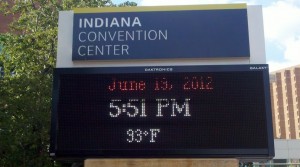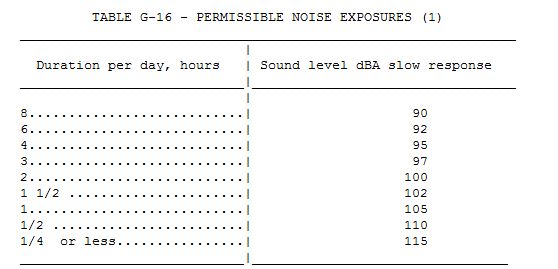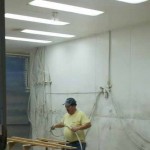The big industrial hygiene conference (AIHCe) is held in a different city each year. This year was Indy, Indiana. Below is my personal top ten list  of “lessons learned” from last week.
- IH’s need to do a better job of sharing. We don’t share data, experiences, information, knowledge or our ideas well.
- CPWR is trying to share. Center for Construction Research & Training. Â I’m looking forward to seeing their published independent review of local exhaust ventilation (LEV) units.
- The minimum exhaust rate for a portable exhaust unit must be 106 cfm (cubic feet per min) to capture particulates (dust, silica) during tuckpointing with a 5 in grinder (but it’s also a good rule of thumb).
- Asphalt milling machines are still a huge silica problem. Water controls are NOT enough. You need a local exhaust system too. (here’s an earlier post I made on it)
- GHS Safety Data Sheets – it’s not as complicated as you think. There are some significant changes, but don’t worry, OSHA’s here to help (ha). Seriously, more information will be available soon.
- Ignite. Have you seen these before? Short, stand up speeches about their ideas/passions. Similar to TED. Some were better than others. But, did I mention they were short?
- Committees. Be careful when you open your mouth. My idea was so great, they are making me do it.
- Â ANSI A10.49! A health standard for construction. Great idea, but lots of work.
- Check out Environment for Children. I don’t know much about it, but they have a great mission.  Believe me, in the US, we’re WAY ahead.
- Presentation. It’s all up to you to make it. I will not cast blame on those who had bad presentations. BUT, it reminds me that I should work on this skill. Even if you have something good to say, if you give a horrible presentation, it’s likely no one will notice. On the other side, if your presentation is good, people will listen, even if you’re talking about nothing! Â My favorite of the week: Dr. Mike Morgan (Univ. of Washington) on Chromium VI. He was very factual, not too flashy, and make the point without needless details.

Posted by admin under Hearing Conservation, hearing protection, Noise
Comments Off on Noise Monitoring – FAQ / Q&As
I get the best questions from employees as I’m setting them up to wear a dosimeter. (FYI- this does not really apply to sound level readings, only dosimetry)
- Why do I have to wear the monitor (dosimeter)? Can’t we just place it in the middle of the area?
Ideally we want the dosimeter to measure the individual exposure. Many factors influence the average noise level, including work practices, location (sound bouncing & dampening), height, proximity to others, equipment, etc.
- What is the dosimeter actually measuring?
A dosimeter measure the sound pressure level, measured in decibels A-weighted, dBA (usually). It can record this level and average it (usually) for every 1 minute period. The amount of information it gathers is staggering…and confusing.
- What if we work a longer shift (more than 8 hours) will the results of the noise monitoring be the same?
Yes, the results are (usually) given as an average. So, in theory, if you measure the noise for 15 minutes and it is the same for the next 7.75 hours, it should be the same. However, if you work more than 8-hours a day OSHA actually decreases the amount of noise you can be exposed to. They have a table (G-16)  that attempts to explain it.  If you know the average level of noise (say it’s an average of 95 dBA 8-hour TWA), then you can determine the time you are allowed (answer: 4 hours).
- How often should noise monitoring be performed?
There is not a specific rule from OSHA on how often you must monitor. However, the guideline is yearly. Â Or if/when significant changes occur “which might effect the results of this testing” (I always use this statement in my reports).
- Which individual employees should have their noise level measured?
It is best to let the industrial hygienist make this determination (there are several good reasons). If you are just starting out, they will often choose an average, or those who might have the highest noise level exposures.
- I’m wearing hearing protection, why don’t they take that into account when they determine the average readings?
Your exposure is determined without regard to the specific type of hearing protection used. If you are wearing the wrong type of hearing protection, or if it is worn incorrectly, you could still have this exposure.
Posted by admin under industrial hygienist, Management, Safety Programs
Comments Off on Top 5 reasons to hire & use an Industrial Hygienist
1. To better understand the levels of exposure(s).
- Â avoid possible exposures to employees, document the non-exposure, show how safely you can perform the work
2. To save $.
- Avoid OSHA fines, worker compensation claims, avoid lawsuits, reduce liability
3. To go “Green”.
- reduce airborne emissions, remove harmful chemicals from the environment & employees, recycle & reuse emissions
4. To increase employee morale.
- investigate employee concerns, change environmental conditions to avoid exposures, increase employee involvement, reduce disgruntlement
5. Increase efficiency.
- doing the job right-the first time, less overhead, better prepared for the project and future projects


